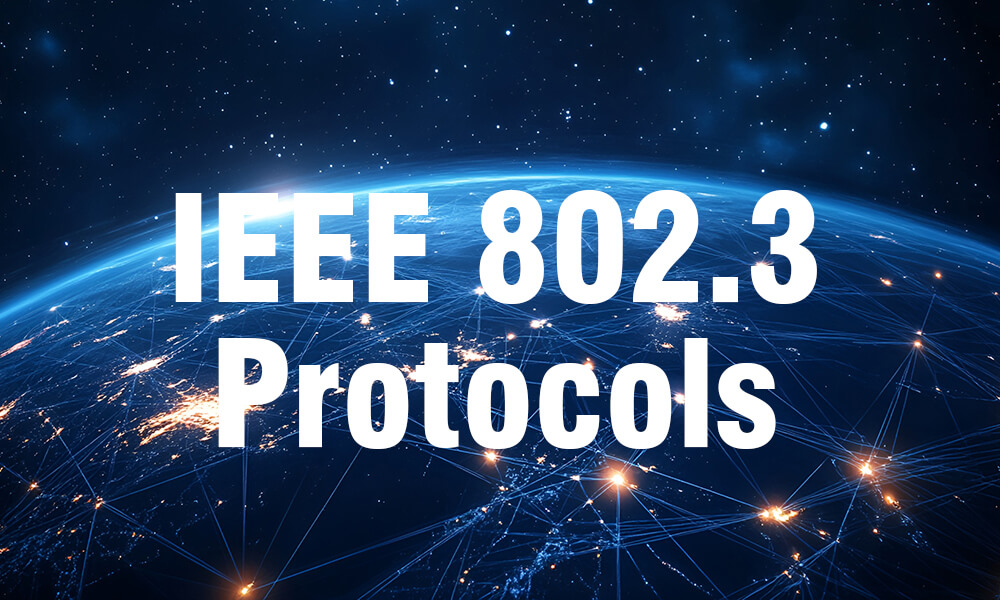IEEE 802.3 Protocols Comparative Guide
The IEEE 802.3 family of standards defines Ethernet technology, the backbone of wired networks. Over time, these protocols have evolved to support faster speeds, longer distances, and new use cases. Let’s first categorize them and then compare the key ones in a table for clarity.
Categories of IEEE 802.3 Protocols
Foundational protocols: These are the early standards that laid the groundwork for Ethernet development, focusing on basic data transmission with relatively low speeds.
High-speed protocols: As data demands increased, these protocols emerged to support gigabit and higher speeds, meeting the needs of large-scale data transmission.
Power Over Ethernet (PoE) protocols: Specifically designed to transmit both power and data over Ethernet cables, expanding the application range of Ethernet.
Comparative Table of Key IEEE 802.3 Protocols
| Protocol | Release Year | Speed | Distance | Key Features | Typical Use Cases |
|---|---|---|---|---|---|
| IEEE 802.3 (Original) | 1983 | 10 Mbps | Up to 500 meters (coaxial cables) | Used thick or thin coaxial cables; bulky and hard to install. | Early office networks connecting a few computers and printers. |
| IEEE 802.3u (Fast Ethernet) | 1995[1] | 100 Mbps | 100 meters (twisted-pair cables, Cat5) | Switched from coaxial to twisted-pair cables, easier installation. | Home and small business networks for early internet use and file sharing. |
| IEEE 802.3ab (Gigabit Ethernet over Copper) | 1999[2] | 1 Gbps | 100 meters (Cat5e or better) | Enabled high-speed transfer over existing copper cables, cost-effective. | Small businesses and homes for video streaming and large file transfers. |
| IEEE 802.3ae (10 Gigabit Ethernet) | 2002 | 10 Gbps | Up to 40 km (single-mode fiber); 300 meters (multimode fiber) | Solved bandwidth bottleneck in large networks. | Data centers and long-haul networks connecting cities. |
| IEEE 802.3bj (40/100 Gigabit Ethernet) | 2014[3] | 40 Gbps and 100 Gbps | Up to 10 km (single-mode fiber) | Uses parallel fiber optic links for ultra-high speeds. | Modern data centers handling cloud services and big data. |
| IEEE 802.3af | 2003 | – | – | Power up to 15.4 watts per device (12.95 watts usable). | IP phones, small Wi-Fi access points. |
| IEEE 802.3bt (PoE++) | 2018[4] | – | – | Power up to 90 watts per device (71.3 watts usable); supports power-hungry devices. | PTZ cameras, LED lights, small industrial sensors. |
How to Choose the Right IEEE 802.3 Protocol
The best protocol depends on your network’s needs:
- home networks: 802.3ab (1 Gbps) is still sufficient for streaming, gaming, and video calls.
- small office: 802.3ae (10 Gbps) works well for connecting multiple offices or a small data center.
- large data centers: 802.3bj (40/100 Gbps) handles the high traffic from cloud services and AI systems.
- PoE devices: Use 802.3bt if you need to power cameras or sensors; 802.3af is enough for basic devices like IP phones.
Conclusion
IEEE 802.3 protocols have driven Ethernet’s evolution from 10 Mbps to 100 Gbps, adapting to new technologies and demands. Whether you’re setting up a home network or a global data center, understanding these standards helps you choose the right tools for reliable, high-speed connectivity.
As data usage grows, we can expect new IEEE 802.3 updates to push speeds even further, keeping Ethernet at the center of wired networks.




